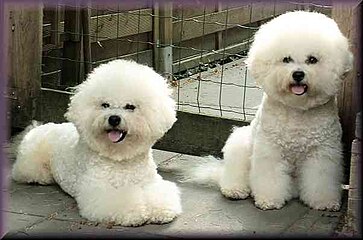|
Bichon Frisé
The Bichon Frisé[a] or Bichon à Poil Frisé is a Franco-Belgian breed of small toy dog of bichon type. It was recognised by the Société Centrale Canine in 1933 and by the Fédération Cynologique Internationale in 1959. EtymologyThe French word bichon comes from Middle French bichon ('small dog'), a diminutive of Old French biche ('female dog', cognate with English bitch), from Old English bicce, and related to other Germanic words with the same meaning, including Old Norse bikkja, and German Betze.[1][2] Some speculate the origin of bichon to be the result of the apheresis, or shortening, of the word barbichon ('small poodle'), a derivative of barbiche ('shaggy dog'); however, this is likely impossible, since the word bichon (attested 1588) is older than barbichon (attested 1694).[3][4] While the English name for the breed, Bichon Frise, is derived from the French bichon à poil frisé meaning 'curly haired small dog'.[5] History The dogs found early success in Spain and it is generally believed that Spanish seamen introduced the early breed to Tenerife in the Canary Islands. Their association with European nobility began in the 13th century, entering the royal courts of Spain, Italy and France.[7] In the 14th century, Italian sailors rediscovered the dogs on their voyages and are credited with returning them to continental Europe.[8] The Bichon à Poil Frisé was recognised by the Société Centrale Canine in 1933.[9] It was definitively accepted by the Fédération Cynologique Internationale in October 1959.[10] Some of the dogs were brought to the United States in 1955[11] and to the United Kingdom in 1973.[12] AppearanceThe Bichon Frisé is a small dog, standing 23–30 cm (9–12 in) at the withers and weighing approximately 5 kg (11 lb), the weight varying in proportion to the height. The skull is rather flat, but may appear rounded; the muzzle tapers only slightly, and constitutes two-fifths of the length of the head. The nose is black, the eyes dark and round.[10] The coat is loosely curled in spirals or corkscrews, with a thick soft undercoat. It is always pure white; only in dogs under a year old may it be slightly tinged with beige, this extending over no more than 10% of the area of the body. The head and legs are proportionate in size to the body.[13] HealthA 2024 UK study found a life expectancy of 12.5 years for the breed compared to an average of 12.7 for purebreeds and 12 for crossbreeds.[14] An American study looking at immune-mediated hemolytic anemia found a predisposition to the condition in the Bichon Frise, with 9% of cases belonging to the breed despite being 2% of the control population.[15] A study in the UK found the Bichon Frise to be predisposed to gall bladder disease (excluding gall bladder mucocele). The Bichon Frise was found to be 9.26 times more likely to acquire a non-mucocele gall bladder disease than other dogs.[16]
Notes
ReferencesWikimedia Commons has media related to Bichon Frisé. Look up Bichon Frisé in Wiktionary, the free dictionary.
Information related to Bichon Frisé |
||||||||||||||||||||||||||||||||||||||||||||||||



